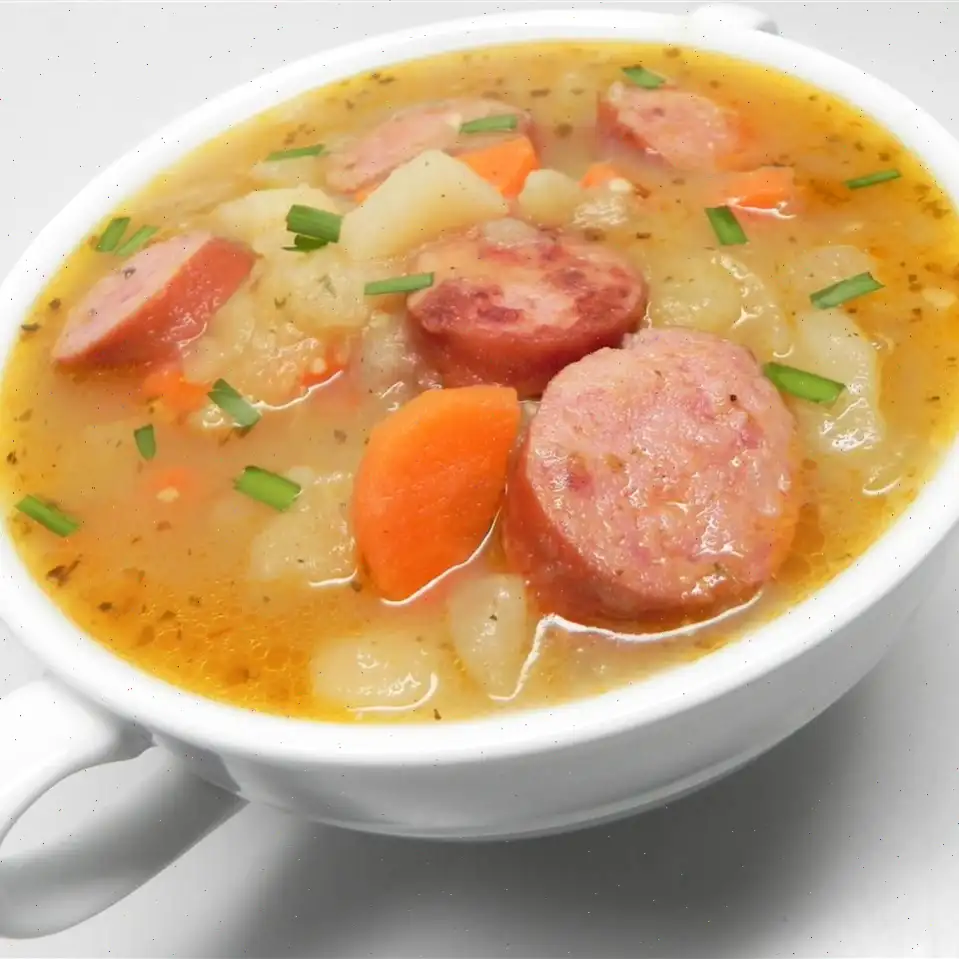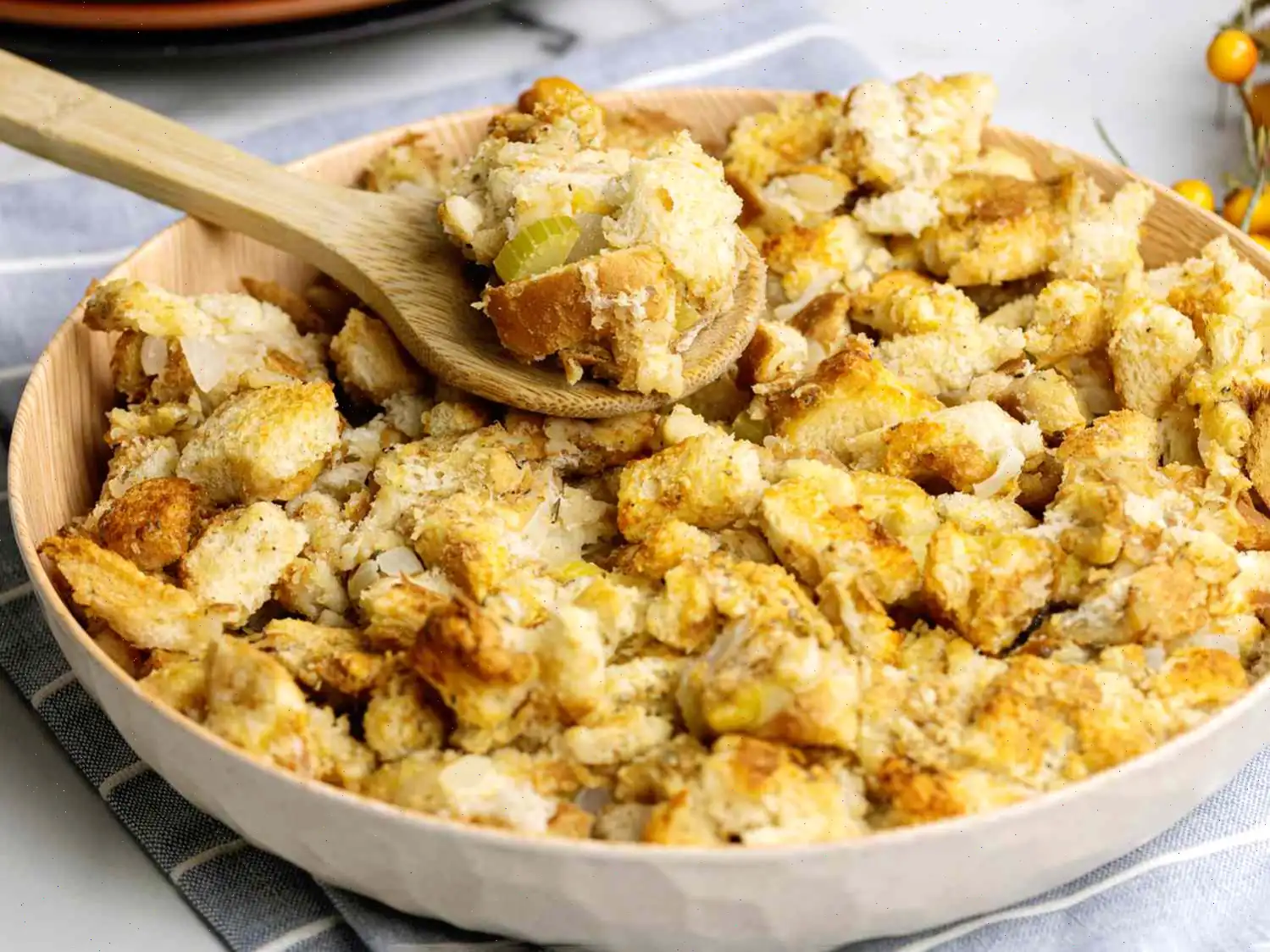
Kartoffelsuppe nach Bayrischer Art (Bavarian Potato Soup) Recipe
This delicious and comforting soup combines hearty pork sausage, tender potatoes, and a variety of vegetables in a flavorful broth. Perfect for a cozy meal with family and friends.
Ingredients (Serves 6)
- 2 links pork sausage
- 3 tablespoons vegetable oil (or to taste)
- 4 pounds potatoes, peeled and cubed
- 4 carrots, cubed
- 2 onions, finely chopped
- 1 leek, trimmed and cubed
- 3 scallions, chopped
- 3 cloves garlic, chopped
- 1 cube vegetable bouillon
- 6 cups hot water
- 1 teaspoon salt (or to taste)
- 1 teaspoon freshly ground black pepper (or to taste)
- 1 pinch dried marjoram (or to taste)
- 1 pinch sweet paprika (or to taste)
- 1 pinch ground nutmeg (or to taste)
- 1 bunch fresh parsley, chopped
- 1 bunch fresh chives, chopped
- cup sour cream (optional)
Directions
- Place the sausages in a small pot and cover them with water. Bring to a boil over medium-high heat. Once boiling, reduce the heat to medium-low and let the sausages simmer for 10 to 15 minutes, or until they are no longer pink in the center. Drain the sausages and slice them into rounds.
- In a large pot, heat the vegetable oil over medium heat. Add the cubed potatoes and cook, stirring often, for about 8 minutes, or until the potatoes begin to crisp on the edges.
- Add the carrots, onions, leek, scallions, and garlic to the pot with the potatoes. Stir well to combine.
- Dissolve the vegetable bouillon cube in the hot water and pour it into the pot. Stir the mixture to combine the flavors. Season the soup with salt, black pepper, marjoram, paprika, and nutmeg.
- Bring the soup to a boil, then reduce the heat and cover the pot. Let it simmer for about 30 minutes, or until the carrots are tender.
- Add the sliced sausages, parsley, and chives to the soup. Stir and let the flavors meld together for about 5 minutes.
- If desired, stir in sour cream just before serving to add a creamy touch to the soup.
Recipe Tip
If you prefer, you can substitute a celery stalk for the leek for a slightly different flavor.
Nutrition Facts (Per Serving)
- Calories: 394
- Total Fat: 11g (14% DV)
- Saturated Fat: 3g (16% DV)
- Cholesterol: 12mg (4% DV)
- Sodium: 524mg (23% DV)
- Total Carbohydrate: 66g (24% DV)
- Dietary Fiber: 10g (36% DV)
- Total Sugars: 7g
- Protein: 11g (22% DV)
- Vitamin C: 93mg (103% DV)
- Calcium: 133mg (10% DV)
- Iron: 4mg (24% DV)
- Potassium: 1687mg (36% DV)
* Percent Daily Values are based on a 2,000-calorie diet. Your daily values may vary depending on your calorie needs.

History of the Dish
Kartoffelsuppe nach Bayrischer Art, or Bavarian Potato Soup, is a traditional dish hailing from the heart of Bavaria, a region in southern Germany known for its hearty and comforting food. This dish has been a staple of Bavarian cuisine for centuries, providing warmth and nourishment through the long, cold winters. The use of locally grown potatoes, vegetables, and pork sausage has made this soup a favorite of both locals and visitors alike. It has evolved over time, with variations found in different parts of Bavaria, but the core ingredients remain unchanged, making it a beloved comfort food.
Regional Characteristics
In Bavaria, Kartoffelsuppe is not just a soup; it is a part of the local culture. The dish is typically made with locally sourced ingredients, including rustic potatoes, hearty sausages, and fresh herbs from the region. The soup is often served during festivals, family gatherings, or casual dinners. The flavor profile is rich and savory, reflecting the use of flavorful meats like pork sausage, and the balance of vegetables adds texture and depth to the dish. The addition of fresh herbs such as parsley and chives gives the soup a vibrant finish, which contrasts with its creamy, hearty base.
Differences from Similar Dishes
While many countries have their own version of potato soup, Bavarian potato soup stands out due to its unique combination of ingredients and flavors. Unlike other potato soups that might be purely vegetarian or use cream as a base, Bavarian Kartoffelsuppe is defined by its inclusion of pork sausage, which gives it a savory and smoky flavor. The use of vegetable bouillon and fresh herbs also adds complexity to the dish, making it different from other potato-based soups found across Europe. Additionally, the practice of sauting the potatoes before simmering them helps to develop a richer, more intense flavor.
Where Its Served
Kartoffelsuppe nach Bayrischer Art is commonly served in rustic Bavarian taverns and beer gardens, where it is enjoyed by locals and tourists alike. It is often part of a traditional Bavarian meal, served as a starter or even as the main course. The soup is also frequently found at festive occasions such as Oktoberfest, where its paired with freshly brewed beer. During colder months, this soup is a favorite comfort food in Bavarian households, often enjoyed after a long day of work or outdoor activities like hiking or skiing.
Interesting Facts
1. The use of pork sausage in Kartoffelsuppe is a reflection of Bavaria's love for hearty meats, particularly pork, which is a key ingredient in many regional dishes. Sausages like Weiwurst (white sausage) or Nrnberger (a smaller, spiced sausage) are popular choices to add depth of flavor to the soup.
2. In some variations of the recipe, potato skins are left on, contributing to a more rustic, textured dish.
3. Bavarians take their soups seriously, and Kartoffelsuppe is often considered a symbol of Bavarian warmth and hospitality. The dish is frequently served in large, communal bowls for sharing, which speaks to the social and family-oriented culture of the region.
4. The soups hearty nature makes it not only a warming dish but also a satisfying one, capable of providing sustenance through long, cold winters in Bavaria.








